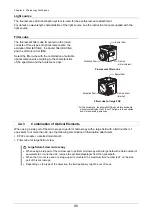
Chapter 4 Microscopy Techniques
88
Advantages of DIC microscopy
•
This microscopy enables observation of the specimens thicker than those for Ph microscopy.
•
Unlike Ph microscopy, this microscopy is free from a halo phenomenon in a boundary of a large structure
and therefore allow minute structure observation.
•
Objectives can be shared with other types of microscopy such as FL microscopy because there is no need
for dedicated objectives, unlike Ph microscopy.
Disadvantages of DIC microscopy
•
This microscopy is suitable only for specimens whose images have orientation and phase contrast in the
direction of shear (direction of the shift of the separated beam)
•
It requires the use of objectives with less distortion (with DIC marking) because distortion of polarization
deteriorates image quality. For specimens that have polarization property (such as plastic dishes), this
microscopy cannot be performed.
4.3.2 Optical
Elements
Required for DIC Microscopy
DIC microscopy requires the following components as well as the status of bright field (those enclosed in
parentheses are for IMSI observation).
•
DIC objective (IMSI objective)
•
DIC polarizer (NAMC/IMSI polarizer)
•
DIC condenser module (IMSI condenser module)
•
Condenser lens
•
DIC slider
•
Analyzer
DIC objective (IMSI objective)
Use differential interference objectives with less
distortion for DIC microscopy.
For the types of DIC sliders that support each
objective, see the table below.
DIC objective
Supported
prism types
















































